Investigating the Seasonal Effect of Climatic Factors on Evapotranspiration in the Monsoon Climate Zone: A Case Study of the Yangtze River Basin
Abstract
1. Introduction
2. Materials and Methods
2.1. Study Area
2.2. Study Data
2.2.1. ET Data
2.2.2. Meteorological Data
2.2.3. Elevation Data
2.3. Methodology
2.3.1. ET Trend Analysis in the YRB
2.3.2. Correlation Analysis
2.3.3. Normalized Multiple Linear Regression Analysis
3. Results
3.1. Temporal and Spatial Variation Characteristics of ET in the YRB
3.1.1. Interannual Variation Characteristics of ET
3.1.2. Variation Characteristics of ET during the Year
3.2. Correlation Analysis between ET and Driving Factors
3.2.1. Correlation Analysis between Air Temperature and ET
3.2.2. Correlation Analysis between Precipitation and ET
3.2.3. Correlation Analysis between Solar Radiation and ET
3.2.4. Correlation Analysis between Specific Humidity and ET
3.2.5. Correlation Analysis between Wind Speed and ET
3.3. Driving Analysis of Temporal and Spatial Variation of ET in the YRB
4. Discussion
4.1. Climatic Factors Drive Monthly ET Influenced by Elevation
4.2. Strengths and Limitations
5. Conclusions
- (1)
- The annual average ET was 592.58 mm, the interannual ET variation fluctuated significantly, and the average value of the interannual ET statistic Z was 0.97, with an overall increasing trend. Among them, the ET of 6.90% of the areas showed a significant decrease trend, while the ET of 34.99% of the areas showed a significant increase trend. Monthly ET increased significantly in January to April, June, and December. Monthly ET decreased significantly in July and November, mainly distributed in the middle and lower reaches of the YRB.
- (2)
- The spatiotemporal distribution of the regions with significant correlation between ET and T, SR, and P in the YRB showed obvious evolution patterns, and the spatial change pattern was strongly related to the elevation. Nevertheless, the regions with significant correlations between monthly ET and SH and U in the YRB did not show obvious cyclical changes in months.
- (3)
- At the annual scale, the area proportion of the dominant climatic factors affecting ET in the study area was SR (35.16%) > SH (34.51) > P (16.84%) > T (7.96%) > U (5.52%). However, monthly ET in most areas of the YRB was driven by SR and T, especially in summer and autumn, while ET in spring and winter was mainly driven by SR, T, and SH.
Author Contributions
Funding
Institutional Review Board Statement
Informed Consent Statement
Data Availability Statement
Conflicts of Interest
References
- Jung, M.; Reichstein, M.; Ciais, P.; Seneviratne, S.I.; Sheffield, J.; Goulden, M.L.; Bonan, G.; Cescatti, A.; Chen, J.; De Jeu, R. Recent decline in the global land evapotranspiration trend due to limited moisture supply. Nature 2010, 467, 951–954. [Google Scholar] [CrossRef] [PubMed]
- Wang, K.; Dickinson, R.E. A review of global terrestrial evapotranspiration: Observation, modeling, climatology, and climatic variability. Rev. Geophys. 2012, 50, 1–54. [Google Scholar] [CrossRef]
- Valipour, M.; Bateni, S.M.; Gholami Sefidkouhi, M.A.; Raeini-Sarjaz, M.; Singh, V.P. Complexity of forces driving trend of reference evapotranspiration and signals of climate change. Atmosphere 2020, 11, 1081. [Google Scholar] [CrossRef]
- Dinpashoh, Y.; Jahanbakhsh-Asl, S.; Rasouli, A.; Foroughi, M.; Singh, V. Impact of climate change on potential evapotranspiration (case study: West and NW of Iran). Theor. Appl. Climatol. 2019, 136, 185–201. [Google Scholar] [CrossRef]
- Wang, M.; Li, M.; Zhang, Z.; Hu, T.; He, G.; Zhang, Z.; Wang, G.; Li, H.; Tan, J.; Liu, X. Land Surface Temperature Retrieval from Landsat 9 TIRS-2 Data Using Radiance-Based Split-Window Algorithm. IEEE J. Sel. Top. Appl. Earth Obs. Remote Sens. 2022, 16, 1100–1112. [Google Scholar] [CrossRef]
- Guo, L.; Sun, F.; Liu, W.; Zhang, Y.; Wang, H.; Cui, H.; Wang, H.; Zhang, J.; Du, B. Response of ecosystem water use efficiency to drought over China during 1982–2015: Spatiotemporal variability and resilience. Forests 2019, 10, 598. [Google Scholar] [CrossRef]
- Jiang, S.; Wei, L.; Ren, L.; Xu, C.-Y.; Zhong, F.; Wang, M.; Zhang, L.; Yuan, F.; Liu, Y. Utility of integrated IMERG precipitation and GLEAM potential evapotranspiration products for drought monitoring over mainland China. Atmos. Res. 2021, 247, 105141. [Google Scholar] [CrossRef]
- Wang, M.; He, C.; Zhang, Z.; Hu, T.; Duan, S.-B.; Mallick, K.; Li, H.; Liu, X. Evaluation of Three Land Surface Temperature Products from Landsat Series Using in Situ Measurements. IEEE Trans. Geosci. Remote Sens. 2023, 61, 5000119. [Google Scholar] [CrossRef]
- Jovic, S.; Nedeljkovic, B.; Golubovic, Z.; Kostic, N. Evolutionary algorithm for reference evapotranspiration analysis. Comput. Electron. Agric. 2018, 150, 1–4. [Google Scholar] [CrossRef]
- Condon, L.E.; Maxwell, R.M. Simulating the sensitivity of evapotranspiration and streamflow to large-scale groundwater depletion. Sci. Adv. 2019, 5, eaav4574. [Google Scholar] [CrossRef]
- Khan, A.; Stöckle, C.O.; Nelson, R.L.; Peters, T.; Adam, J.C.; Lamb, B.; Chi, J.; Waldo, S. Estimating biomass and yield using metric evapotranspiration and simple growth algorithms. Agron. J. 2019, 111, 536–544. [Google Scholar] [CrossRef]
- Mahmoodi-Eshkaftaki, M.; Rafiee, M.R. Optimization of irrigation management: A multi-objective approach based on crop yield, growth, evapotranspiration, water use efficiency and soil salinity. J. Clean. Prod. 2020, 252, 119901. [Google Scholar] [CrossRef]
- Zhang, F.; Geng, M.; Wu, Q.; Liang, Y. Study on the spatial-temporal variation in evapotranspiration in China from 1948 to 2018. Sci. Rep. 2020, 10, 17139. [Google Scholar] [CrossRef]
- Feng, K.; Tian, J. Forecasting reference evapotranspiration using data mining and limited climatic data. Eur. J. Remote Sens. 2021, 54, 363–371. [Google Scholar] [CrossRef]
- Zhang, Y.; Wang, M.; Chen, J.; Zhong, P.-a.; Wu, X.; Wu, S. Multiscale attribution analysis for assessing effects of changing environment on runoff: Case study of the Upstream Yangtze River in China. J. Water Clim. Chang. 2021, 12, 627–646. [Google Scholar] [CrossRef]
- Lu, S.; Tang, X.; Guan, X.; Qin, F.; Liu, X.; Zhang, D. The assessment of forest ecological security and its determining indicators: A case study of the Yangtze River Economic Belt in China. J. Environ. Manag. 2020, 258, 110048. [Google Scholar] [CrossRef]
- Huang, T.; Xu, L.; Fan, H. Drought characteristics and its response to the global climate variability in the yangtze river basin, China. Water 2018, 11, 13. [Google Scholar] [CrossRef]
- Jiang, W.; Wang, L.; Feng, L.; Zhang, M.; Yao, R. Drought characteristics and its impact on changes in surface vegetation from 1981 to 2015 in the Yangtze River Basin, China. Int. J. Climatol. 2020, 40, 3380–3397. [Google Scholar] [CrossRef]
- Wang, M.; Zhang, Y.; Lu, Y.; Gong, X.; Gao, L. Detection and attribution of reference evapotranspiration change (1951–2020) in the Upper Yangtze River Basin of China. J. Water Clim. Chang. 2021, 12, 2624–2638. [Google Scholar] [CrossRef]
- Wang, Y.; Jiang, T.; Bothe, O.; Fraedrich, K. Changes of pan evaporation and reference evapotranspiration in the Yangtze River basin. Theor. Appl. Climatol. 2007, 90, 13–23. [Google Scholar] [CrossRef]
- Wang, Y.; Liu, B.; Su, B.; Zhai, J.; Gemmer, M. Trends of calculated and simulated actual evaporation in the Yangtze River basin. J. Clim. 2011, 24, 4494–4507. [Google Scholar] [CrossRef]
- Lu, J.; Wang, G.; Gong, T.; Hagan, D.F.T.; Wang, Y.; Jiang, T.; Su, B. Changes of actual evapotranspiration and its components in the Yangtze River valley during 1980–2014 from satellite assimilation product. Theor. Appl. Climatol. 2019, 138, 1493–1510. [Google Scholar] [CrossRef]
- Wang, W.; Shao, Q.; Peng, S.; Xing, W.; Yang, T.; Luo, Y.; Yong, B.; Xu, J. Reference evapotranspiration change and the causes across the Yellow River Basin during 1957–2008 and their spatial and seasonal differences. Water Resour. Res. 2012, 48, 1–27. [Google Scholar] [CrossRef]
- Xu, C.-y.; Gong, L.; Jiang, T.; Chen, D.; Singh, V. Analysis of spatial distribution and temporal trend of reference evapotranspiration and pan evaporation in Changjiang (Yangtze River) catchment. J. Hydrol. 2006, 327, 81–93. [Google Scholar] [CrossRef]
- Xu, Y.; Xu, Y.; Wang, Y.; Wu, L.; Li, G.; Song, S. Spatial and temporal trends of reference crop evapotranspiration and its influential variables in Yangtze River Delta, eastern China. Theor. Appl. Climatol. 2017, 130, 945–958. [Google Scholar] [CrossRef]
- Herath, I.K.; Ye, X.; Wang, J.; Bouraima, A.-K. Spatial and temporal variability of reference evapotranspiration and influenced meteorological factors in the Jialing River Basin, China. Theor. Appl. Climatol. 2018, 131, 1417–1428. [Google Scholar] [CrossRef]
- Al-Sudani, H.I.Z. Study of Morphometric Properties and Water Balance Using Thornthwaite Method in Khanaqin Basin, East of Iraq. J. Univ. Babylon Eng. Sci. 2018, 26, 165–175. [Google Scholar]
- Bo, L.; Qi, H.; Wenpeng, W.; Xiaofan, Z.; Jianqing, Z. Variation of actual evapotranspiration and its impact on regional water resources in the Upper Reaches of the Yangtze River. Quat. Int. 2011, 244, 185–193. [Google Scholar] [CrossRef]
- Yang, L.; Feng, Q.; Zhu, M.; Wang, L.; Alizadeh, M.R.; Adamowski, J.F.; Wen, X.; Yin, Z. Variation in actual evapotranspiration and its ties to climate change and vegetation dynamics in northwest China. J. Hydrol. 2022, 607, 127533. [Google Scholar] [CrossRef]
- Lv, X.; Zuo, Z.; Sun, J.; Ni, Y.; Wang, Z. Climatic and human-related indicators and their implications for evapotranspiration management in a watershed of Loess Plateau, China. Ecol. Indic. 2019, 101, 143–149. [Google Scholar] [CrossRef]
- Ma, Z.; Yan, N.; Wu, B.; Stein, A.; Zhu, W.; Zeng, H. Variation in actual evapotranspiration following changes in climate and vegetation cover during an ecological restoration period (2000–2015) in the Loess Plateau, China. Sci. Total Environ. 2019, 689, 534–545. [Google Scholar] [CrossRef]
- Li, C.; Zhang, Y.; Shen, Y.; Kong, D.; Zhou, X. LUCC-driven changes in gross primary production and actual evapotranspiration in northern China. J. Geophys. Res. Atmos. 2020, 125, e2019JD031705. [Google Scholar] [CrossRef]
- Gong, L.; Xu, C.-y.; Chen, D.; Halldin, S.; Chen, Y.D. Sensitivity of the Penman–Monteith reference evapotranspiration to key climatic variables in the Changjiang (Yangtze River) basin. J. Hydrol. 2006, 329, 620–629. [Google Scholar] [CrossRef]
- Qu, X.; Chen, Y.; Liu, H.; Xia, W.; Lu, Y.; Gang, D.-D.; Lin, L.-S. A holistic assessment of water quality condition and spatiotemporal patterns in impounded lakes along the eastern route of China’s South-to-North water diversion project. Water Res. 2020, 185, 116275. [Google Scholar] [CrossRef]
- Chen, Y.; Fok, H.S.; Ma, Z.; Tenzer, R. Improved remotely sensed total basin discharge and its seasonal error characterization in the Yangtze River Basin. Sensors 2019, 19, 3386. [Google Scholar] [CrossRef]
- Kong, L.; Zheng, H.; Xiao, Y.; Ouyang, Z.; Li, C.; Zhang, J.; Huang, B. Mapping ecosystem service bundles to detect distinct types of multifunctionality within the diverse landscape of the yangtze river basin, China. Sustainability 2018, 10, 857. [Google Scholar] [CrossRef]
- Zhang, Y.; Kong, D.; Gan, R.; Chiew, F.H.; McVicar, T.R.; Zhang, Q.; Yang, Y. Coupled estimation of 500 m and 8-day resolution global evapotranspiration and gross primary production in 2002–2017. Remote Sens. Environ. 2019, 222, 165–182. [Google Scholar] [CrossRef]
- Wu, D.; Wu, H.; Zhao, X.; Zhou, T.; Tang, B.; Zhao, W.; Jia, K. Evaluation of spatiotemporal variations of global fractional vegetation cover based on GIMMS NDVI data from 1982 to 2011. Remote Sens. 2014, 6, 4217–4239. [Google Scholar] [CrossRef]
- Dinpashoh, Y.; Mirabbasi, R.; Jhajharia, D.; Abianeh, H.Z.; Mostafaeipour, A. Effect of short-term and long-term persistence on identification of temporal trends. J. Hydrol. Eng. 2014, 19, 617–625. [Google Scholar] [CrossRef]
- Jiang, W.; Yuan, L.; Wang, W.; Cao, R.; Zhang, Y.; Shen, W. Spatio-temporal analysis of vegetation variation in the Yellow River Basin. Ecol. Indic. 2015, 51, 117–126. [Google Scholar] [CrossRef]
- Sen, P.K. Estimates of the regression coefficient based on Kendall’s tau. J. Am. Stat. Assoc. 1968, 63, 1379–1389. [Google Scholar] [CrossRef]
- Mondal, A.; Kundu, S.; Mukhopadhyay, A. Rainfall trend analysis by Mann-Kendall test: A case study of north-eastern part of Cuttack district, Orissa. Int. J. Geol. Earth Environ. Sci. 2012, 2, 70–78. [Google Scholar]
- Yang, L.; Feng, Q.; Yin, Z.; Wen, X.; Si, J.; Li, C.; Deo, R.C. Identifying separate impacts of climate and land use/cover change on hydrological processes in upper stream of Heihe River, Northwest China. Hydrol. Process. 2017, 31, 1100–1112. [Google Scholar] [CrossRef]
- Salas, J.D. Applied Modeling of Hydrologic Time Series; Water Resources Publications: Littleton, CO, USA, 1980. [Google Scholar]
- Kendall, M.G.; Stuart, A. The Advanced Theory of Statistics: Design and Analysis, and Time-Series; Griffin: Duxbury, MA, USA, 1958. [Google Scholar]
- Yadeta, D.; Kebede, A.; Tessema, N. Potential evapotranspiration models evaluation, modelling, and projection under climate scenarios, Kesem sub-basin, Awash River basin, Ethiopia. Model. Earth Syst. Environ. 2020, 6, 2165–2176. [Google Scholar] [CrossRef]
- Shamshirband, S.; Hashemi, S.; Salimi, H.; Samadianfard, S.; Asadi, E.; Shadkani, S.; Kargar, K.; Mosavi, A.; Nabipour, N.; Chau, K.-W. Predicting standardized streamflow index for hydrological drought using machine learning models. Eng. Appl. Comput. Fluid Mech. 2020, 14, 339–350. [Google Scholar] [CrossRef]
- Sun, S.; Song, Z.; Chen, X.; Wang, T.; Zhang, Y.; Zhang, D.; Zhang, H.; Hao, Q.; Chen, B. Multimodel-based analyses of evapotranspiration and its controls in China over the last three decades. Ecohydrology 2020, 13, e2195. [Google Scholar] [CrossRef]
- Sun, J.; Wang, G.; Sun, X.; Lin, S.; Hu, Z.; Huang, K. Elevation-dependent changes in reference evapotranspiration due to climate change. Hydrol. Process. 2020, 34, 5580–5594. [Google Scholar] [CrossRef]
- Wang, Q.; Wang, J.; Zhao, Y.; Li, H.; Zhai, J.; Yu, Z.; Zhang, S. Reference evapotranspiration trends from 1980 to 2012 and their attribution to meteorological drivers in the three-river source region, China. Int. J. Climatol. 2016, 36, 3759–3769. [Google Scholar] [CrossRef]
- Collados-Lara, A.J.; Pardo-Igúzquiza, E.; Pulido-Velazquez, D.; Jiménez-Sánchez, J. Precipitation fields in an alpine Mediterranean catchment: Inversion of precipitation gradient with elevation or undercatch of snowfall? Int. J. Climatol. 2018, 38, 3565–3578. [Google Scholar] [CrossRef]
- Pei, Y.; Dong, J.; Zhang, Y.; Yang, J.; Zhang, Y.; Jiang, C.; Xiao, X. Performance of four state-of-the-art GPP products (VPM, MOD17, BESS and PML) for grasslands in drought years. Ecol. Inf. 2020, 56, 101052. [Google Scholar] [CrossRef]
- Bai, H.; Ming, Z.; Zhong, Y.; Zhong, M.; Kong, D.; Ji, B. Evaluation of evapotranspiration for exorheic basins in China using an improved estimate of terrestrial water storage change. J. Hydrol. 2022, 610, 127885. [Google Scholar] [CrossRef]
- He, S.; Zhang, Y.; Ma, N.; Tian, J.; Kong, D.; Liu, C. A daily and 500 m coupled evapotranspiration and gross primary production product across China during 2000–2020. Earth Syst. Sci. Data Discuss. 2022, 14, 5463–5488. [Google Scholar] [CrossRef]
- Ji, Y.; Tang, Q.; Yan, L.; Wu, S.; Yan, L.; Tan, D.; Chen, J.; Chen, Q. Spatiotemporal Variations and Influencing Factors of Terrestrial Evapotranspiration and Its Components during Different Impoundment Periods in the Three Gorges Reservoir Area. Water 2021, 13, 2111. [Google Scholar] [CrossRef]
- Zhan, Y.; Zhang, W.; Yan, Y.; Wang, C.; Rong, Y.; Zhu, J.; Lu, H.; Zheng, T. Anaysis of actual evapotranspiration evolution and influencing factors in the Yangtze River Basin. Acta Ecol. Sin. 2021, 41, 1–12. [Google Scholar]
- Ye, X.; Li, X.; Liu, J.; Xu, C.Y.; Zhang, Q. Variation of reference evapotranspiration and its contributing climatic factors in the Poyang Lake catchment, China. Hydrol. Process. 2014, 28, 6151–6162. [Google Scholar] [CrossRef]
- Li, X.; He, Y.; Zeng, Z.; Lian, X.; Wang, X.; Du, M.; Jia, G.; Li, Y.; Ma, Y.; Tang, Y. Spatiotemporal pattern of terrestrial evapotranspiration in China during the past thirty years. Agric. For. Meteorol. 2018, 259, 131–140. [Google Scholar] [CrossRef]
- Li, Q.; Luo, Z.; Zhong, B.; Zhou, H. An improved approach for evapotranspiration estimation using water balance equation: Case study of Yangtze River Basin. Water 2018, 10, 812. [Google Scholar] [CrossRef]
- Chen, Y.; Xia, J.; Liang, S.; Feng, J.; Fisher, J.B.; Li, X.; Li, X.; Liu, S.; Ma, Z.; Miyata, A. Comparison of satellite-based evapotranspiration models over terrestrial ecosystems in China. Remote Sens. Environ. 2014, 140, 279–293. [Google Scholar] [CrossRef]
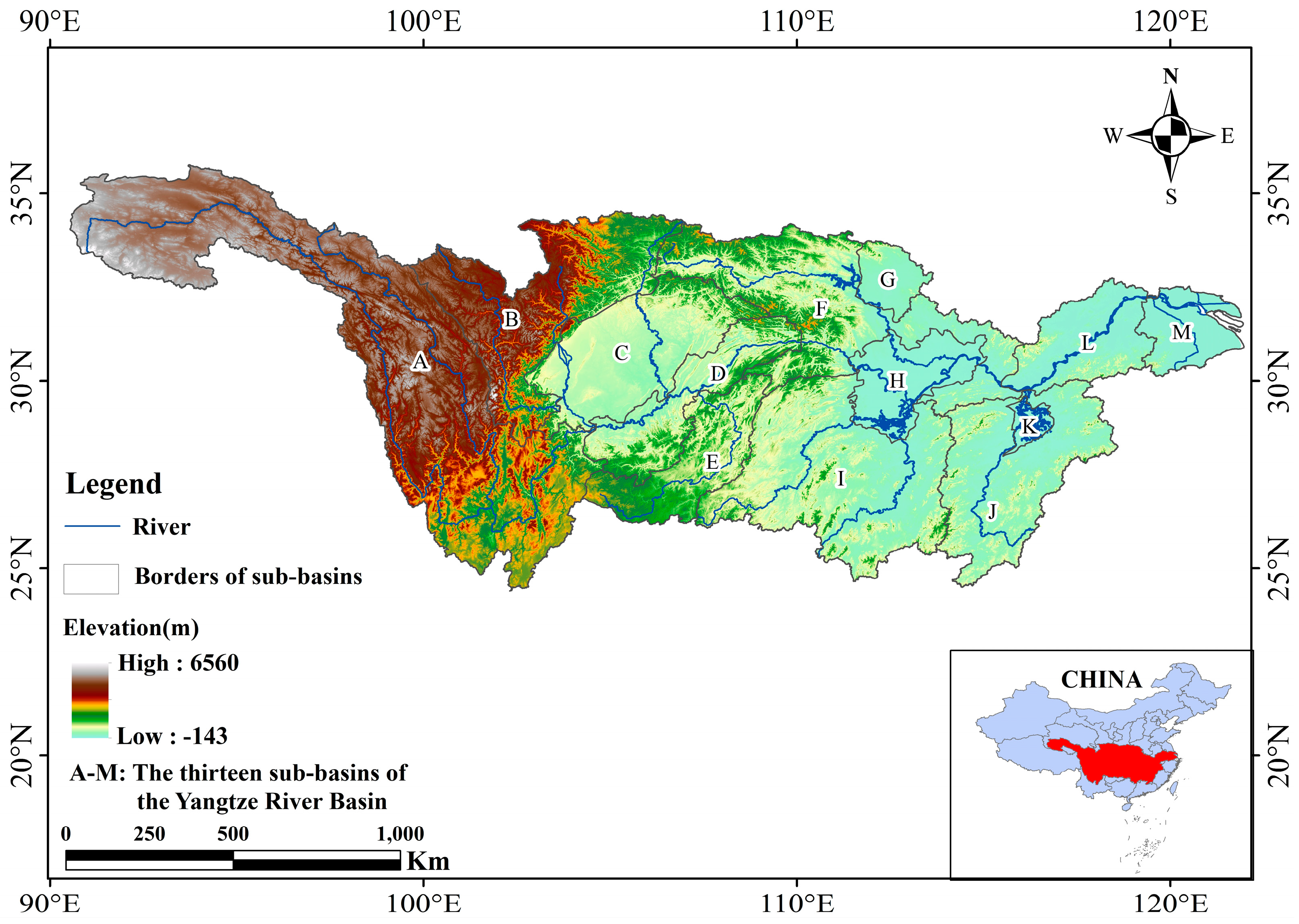
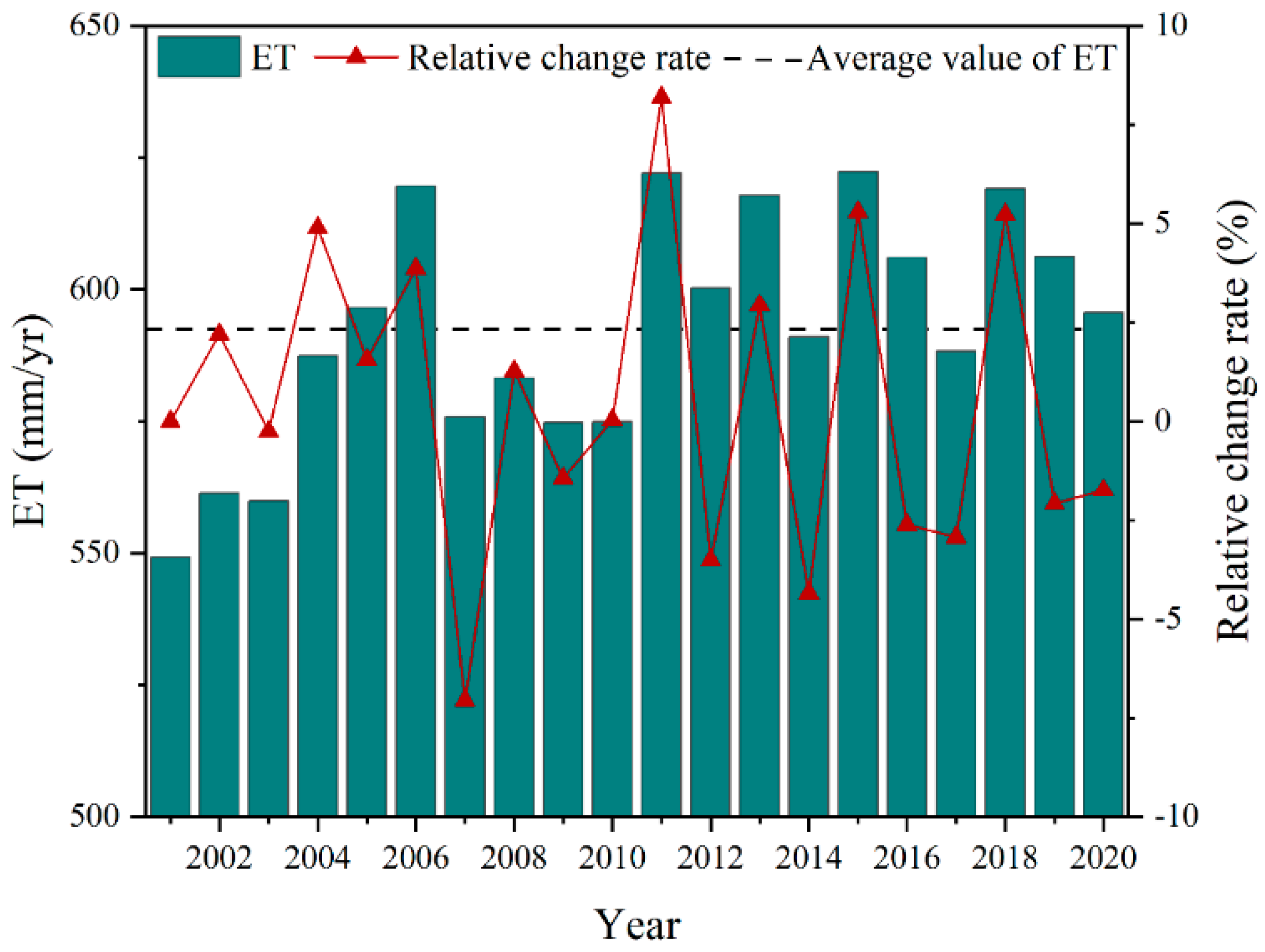
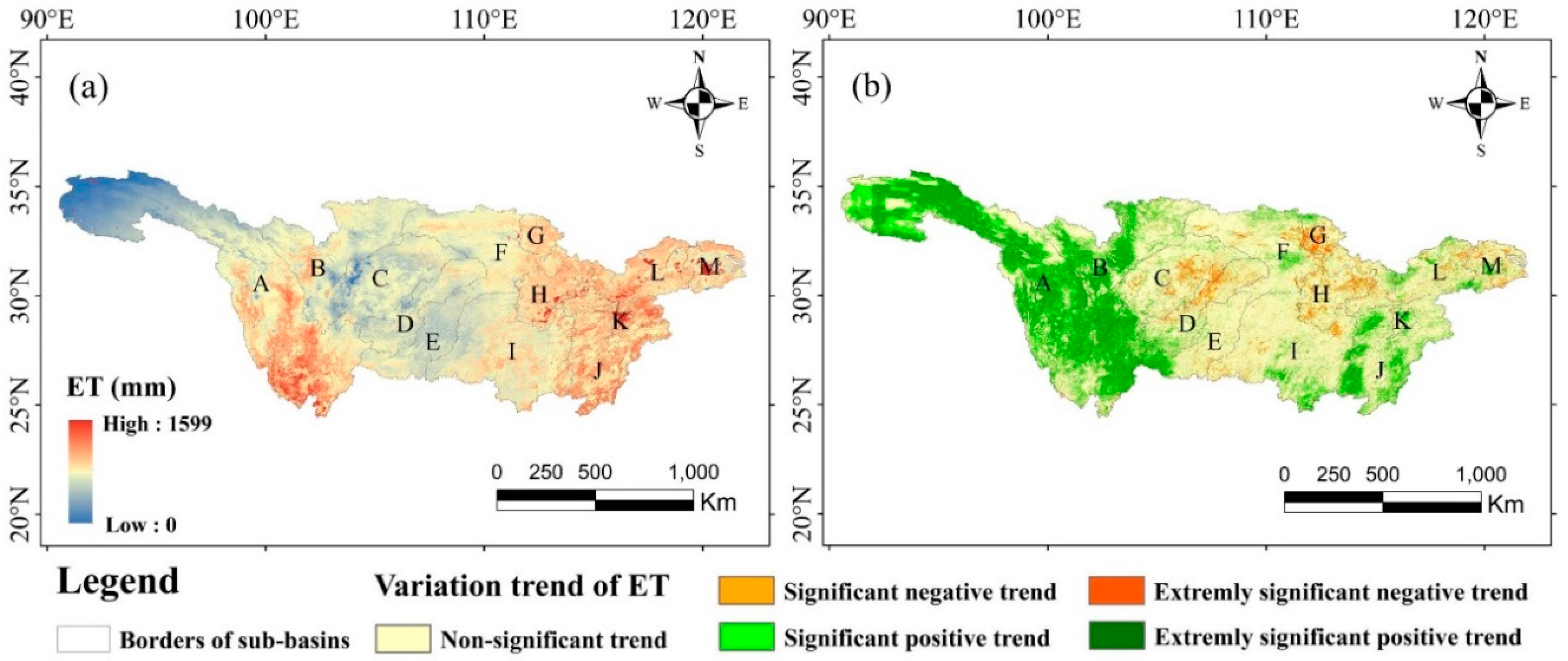
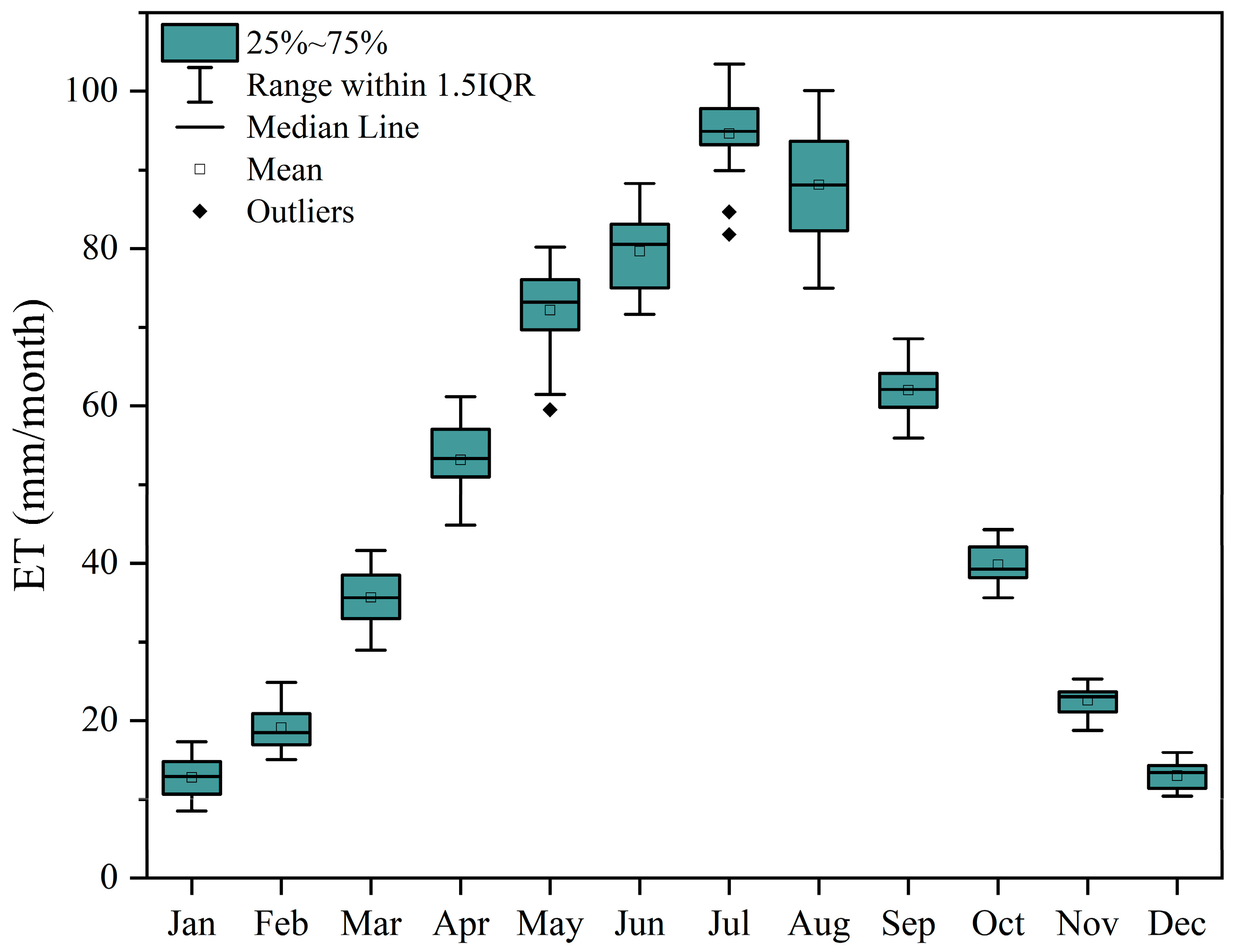
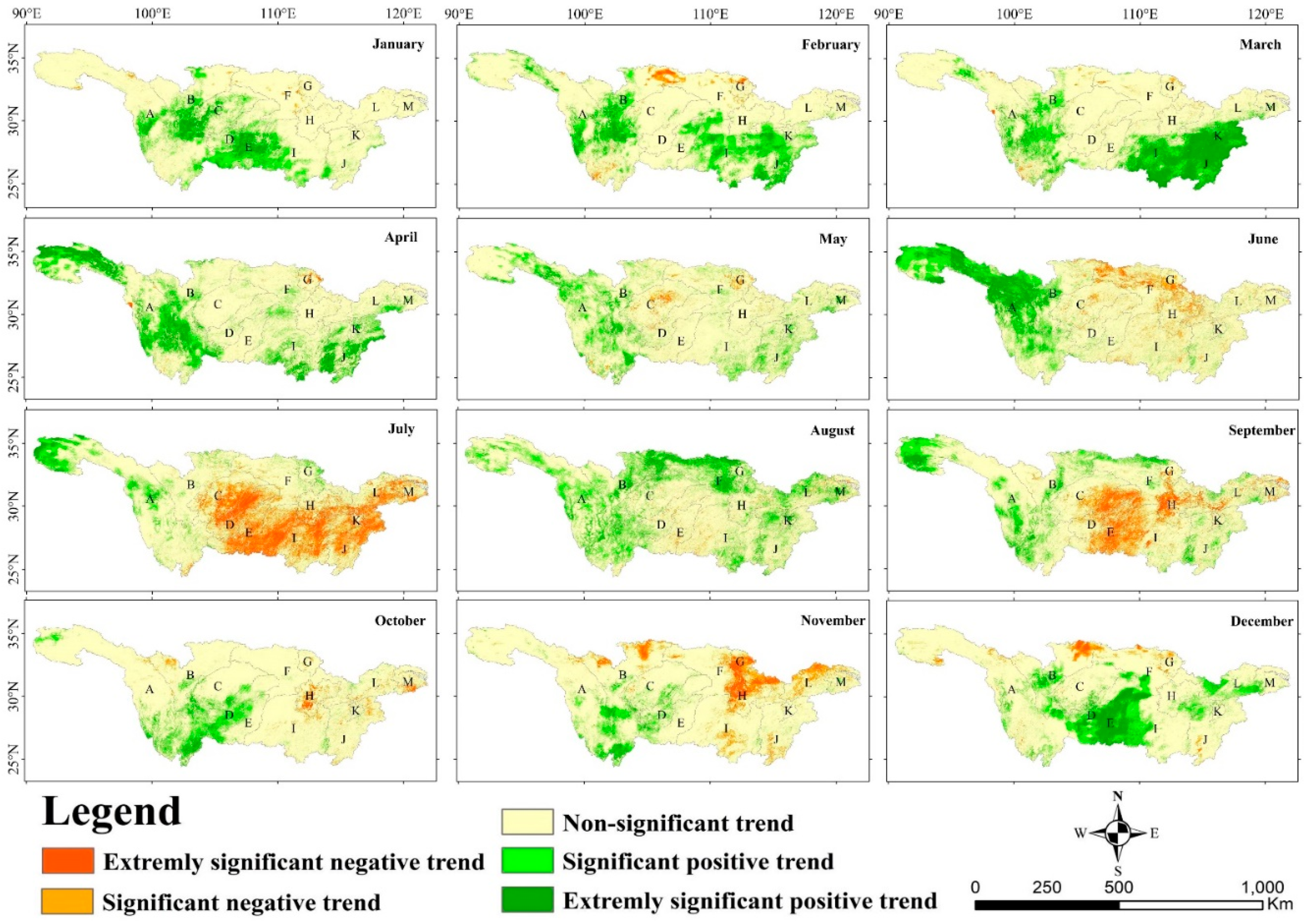

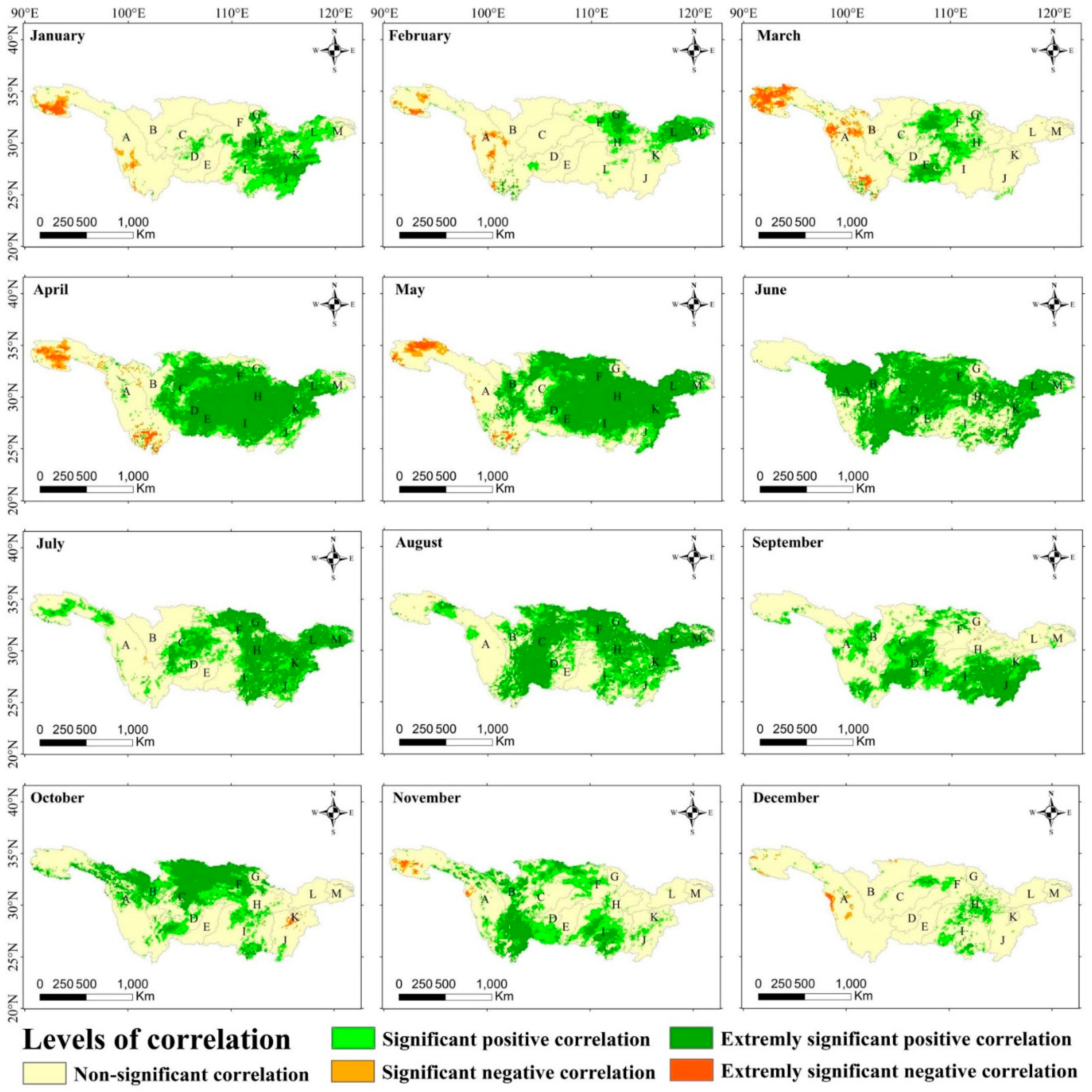

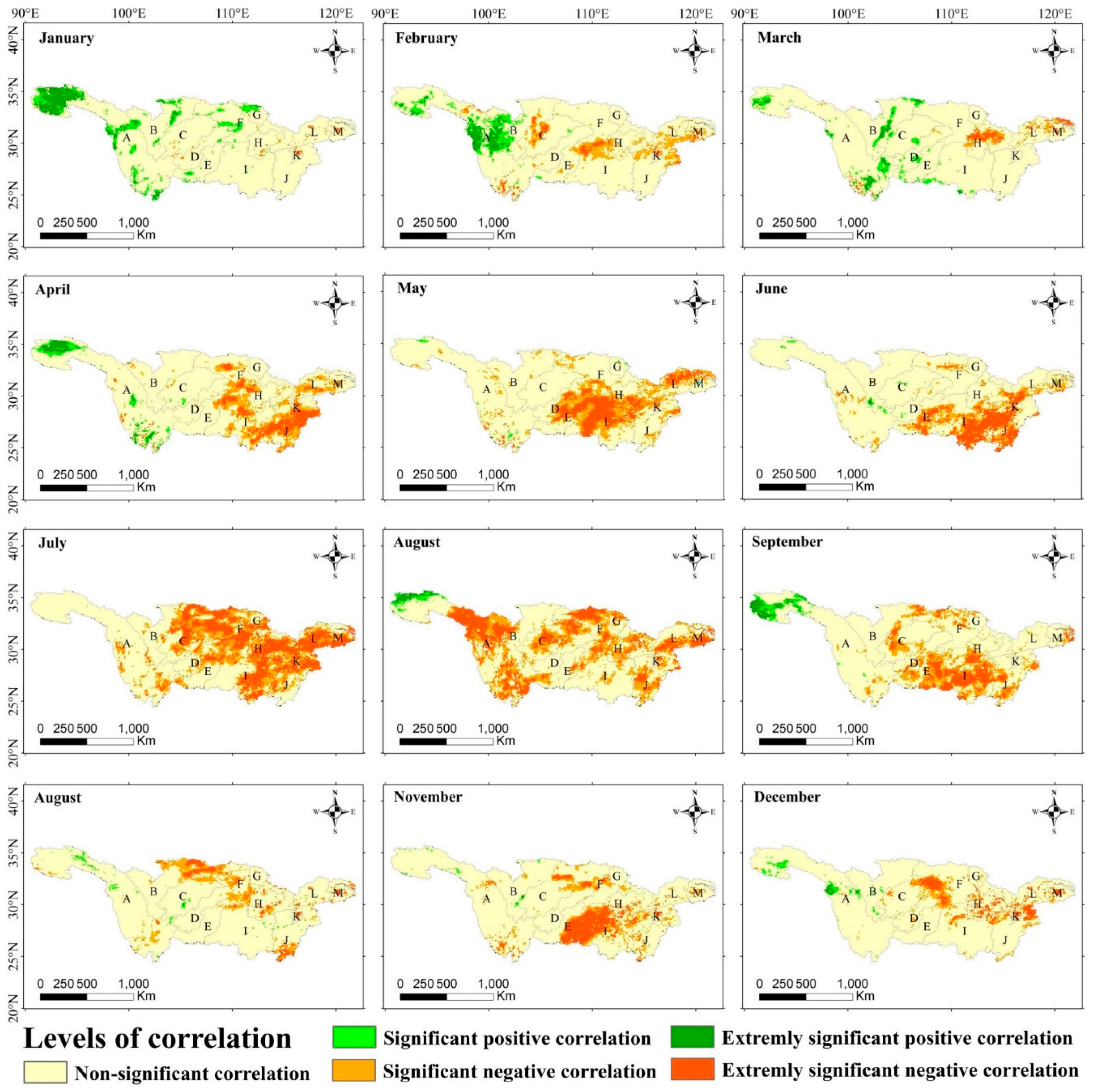

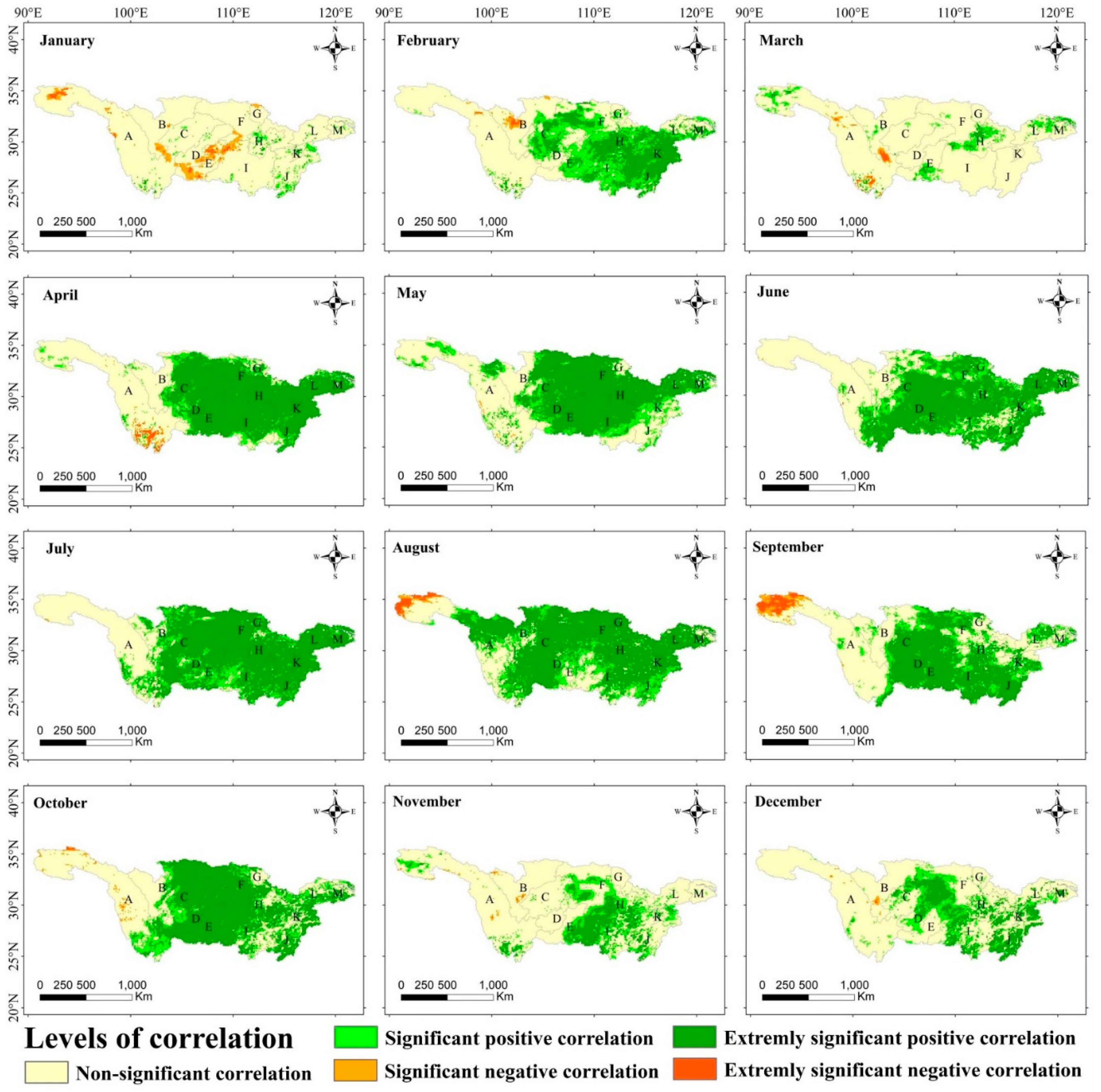
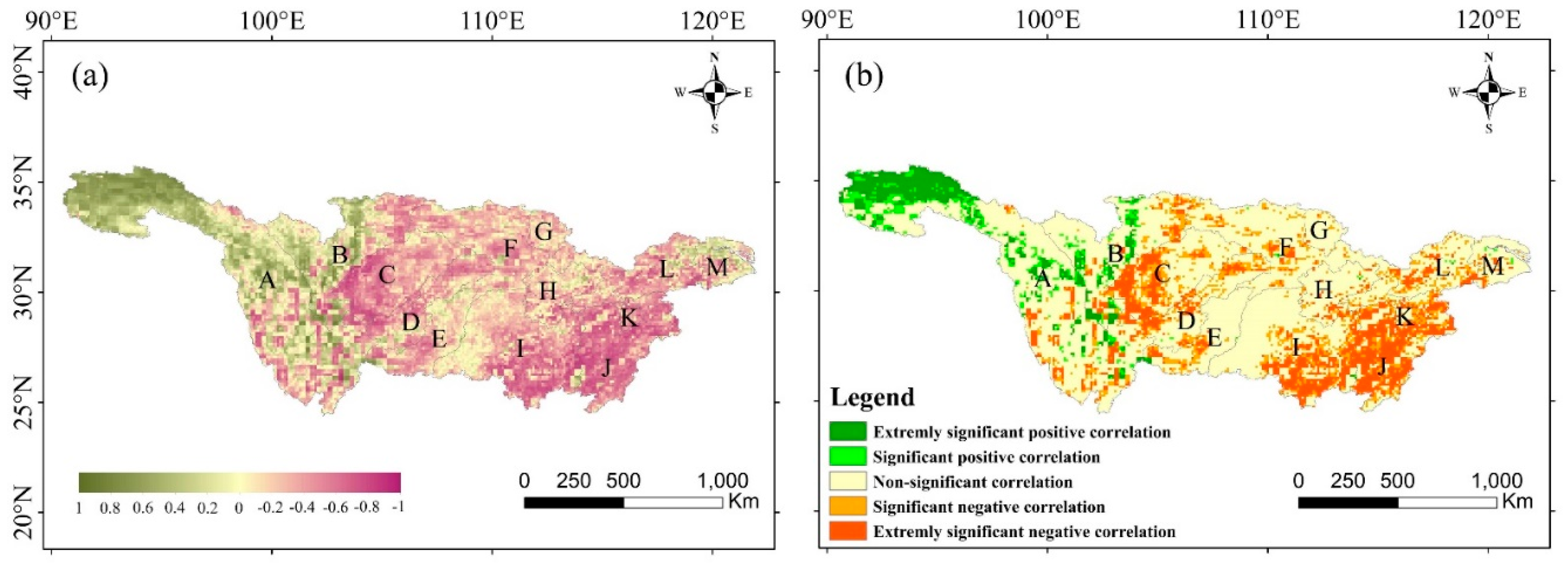
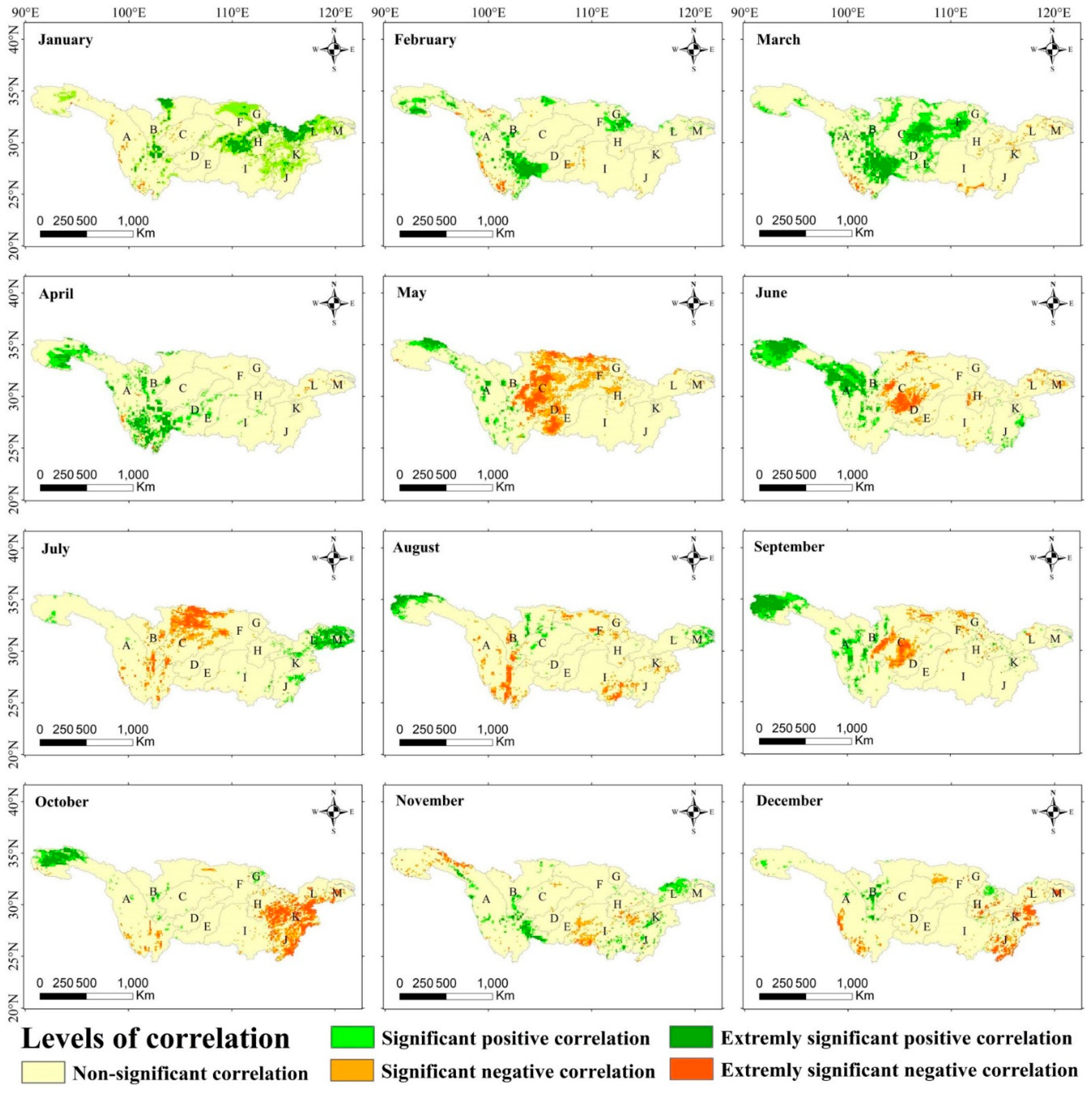

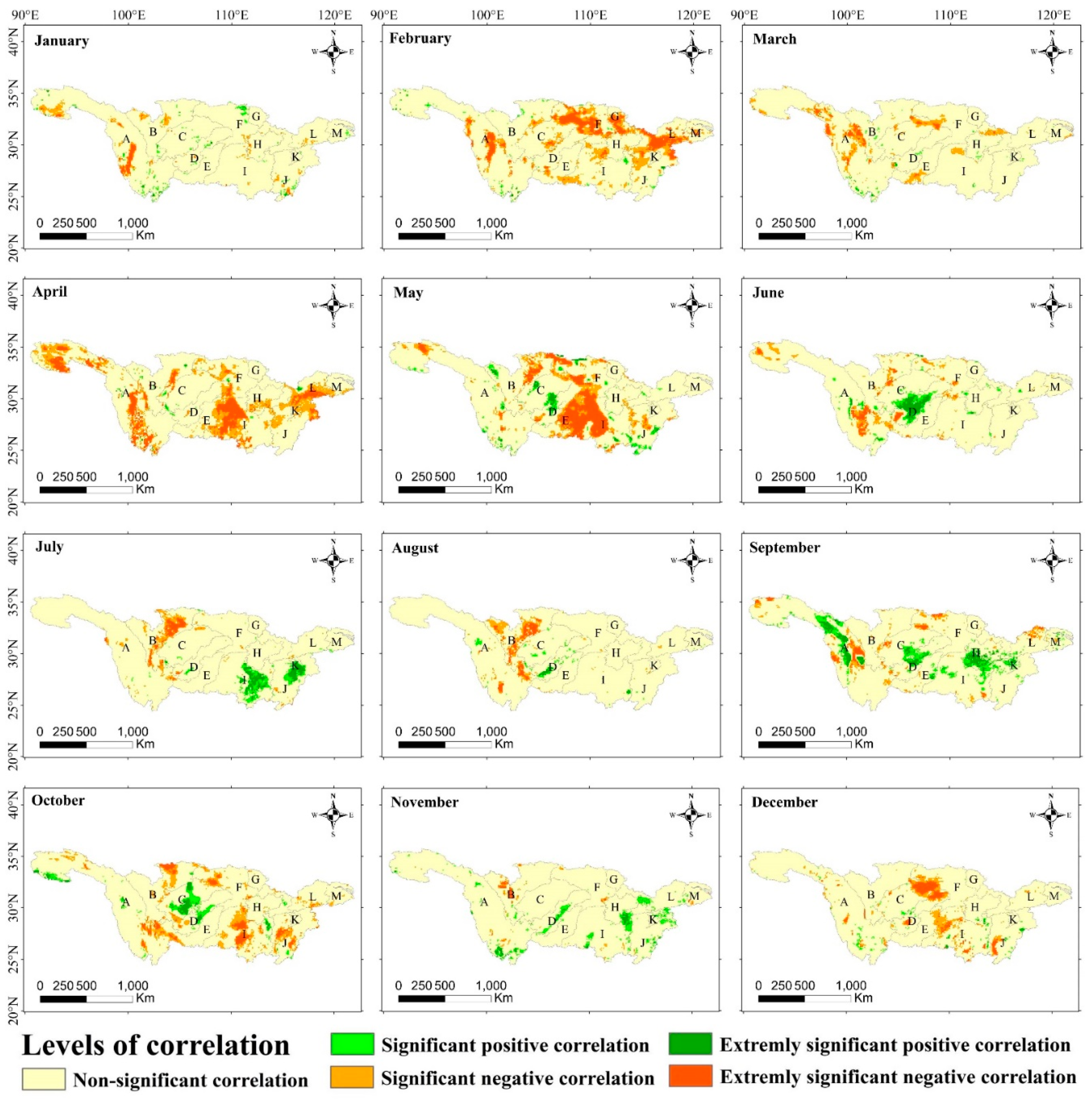

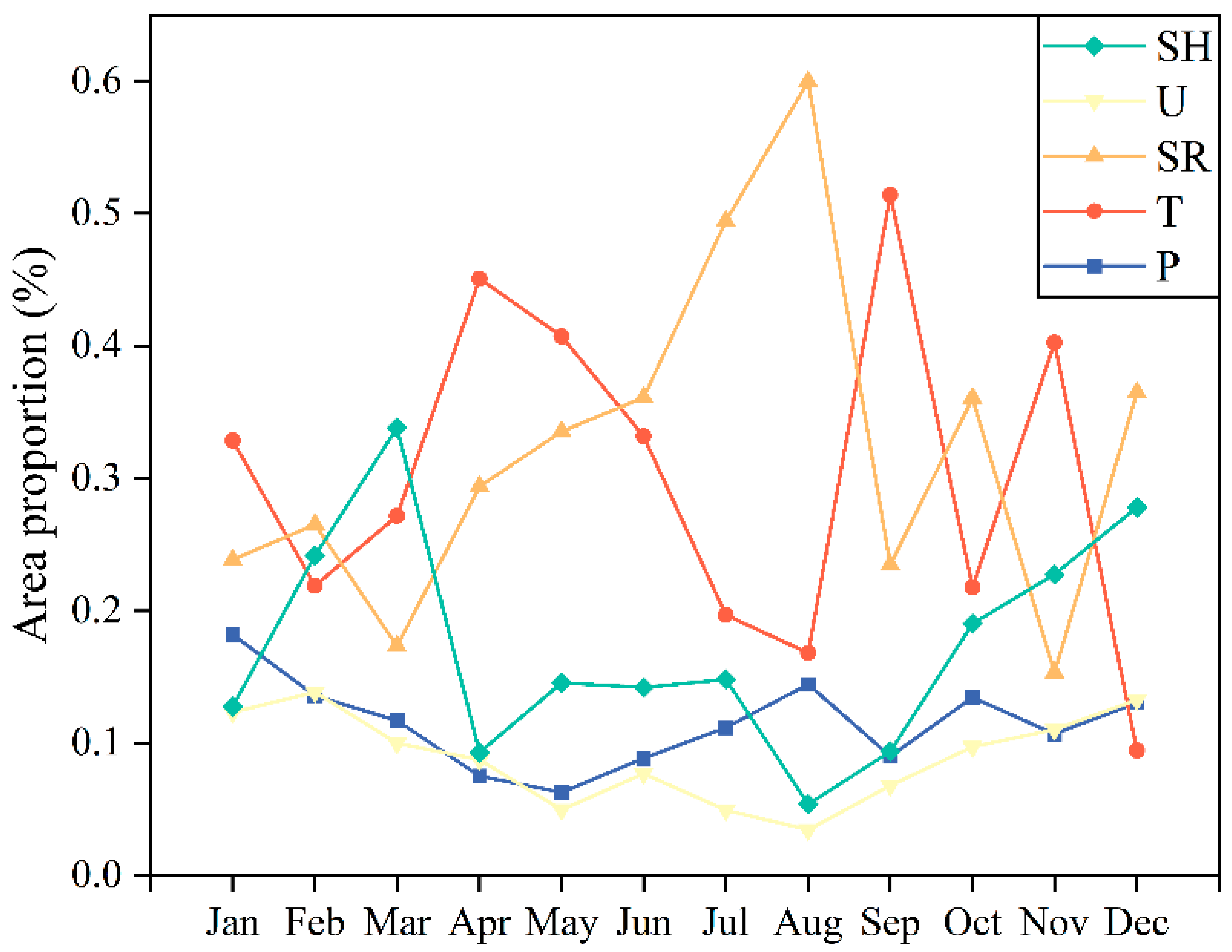
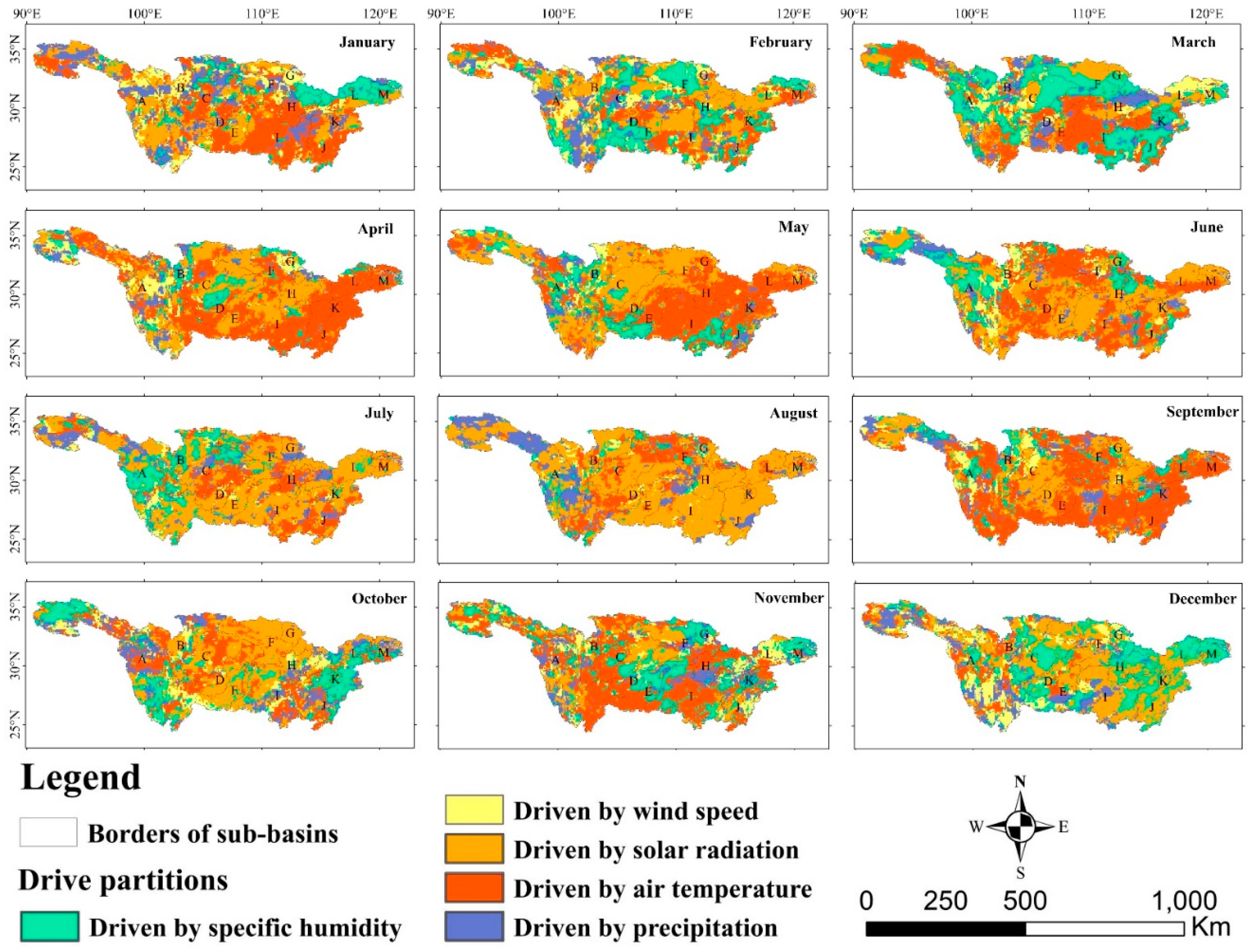

| Level of variation | Extremely significant negative trend | Significant negative trend | Non-significant trend | Significant positive trend | Extremely significant positive trend |
| Case | < 0 and ≤ 0.01 | < 0 and 0.01 < ≤ 0.05 | > 0.05 | and 0.01 < ≤ 0.05 | and ≤ 0.01 |
| Level | Elevation Interval/m | Area/km2 | Percentage/% |
|---|---|---|---|
| I | −143~500 | 69.90 | 38.83% |
| II | 500~1000 | 28.02 | 15.56% |
| III | 1000~1500 | 16.08 | 8.94% |
| IV | 1500~2000 | 9.28 | 5.15% |
| V | 2000~2500 | 8.20 | 4.55% |
| VI | 2500~3000 | 5.16 | 2.86% |
| VII | 3000~3500 | 4.88 | 2.71% |
| VIII | 3500~4000 | 7.07 | 3.93% |
| IX | 4000~4500 | 13.05 | 7.25% |
| X | 4500~5000 | 15.94 | 8.86% |
| XI | 5000~5500 | 2.23 | 1.24% |
| XII | >5500 | 0.19 | 0.11% |
Disclaimer/Publisher’s Note: The statements, opinions and data contained in all publications are solely those of the individual author(s) and contributor(s) and not of MDPI and/or the editor(s). MDPI and/or the editor(s) disclaim responsibility for any injury to people or property resulting from any ideas, methods, instructions or products referred to in the content. |
© 2023 by the authors. Licensee MDPI, Basel, Switzerland. This article is an open access article distributed under the terms and conditions of the Creative Commons Attribution (CC BY) license (https://creativecommons.org/licenses/by/4.0/).
Share and Cite
Wang, M.; Li, M.; An, Q.; Zhang, Z.; Lu, J. Investigating the Seasonal Effect of Climatic Factors on Evapotranspiration in the Monsoon Climate Zone: A Case Study of the Yangtze River Basin. Atmosphere 2023, 14, 1282. https://doi.org/10.3390/atmos14081282
Wang M, Li M, An Q, Zhang Z, Lu J. Investigating the Seasonal Effect of Climatic Factors on Evapotranspiration in the Monsoon Climate Zone: A Case Study of the Yangtze River Basin. Atmosphere. 2023; 14(8):1282. https://doi.org/10.3390/atmos14081282
Chicago/Turabian StyleWang, Mengmeng, Miao Li, Qing An, Zhengjia Zhang, and Jing Lu. 2023. "Investigating the Seasonal Effect of Climatic Factors on Evapotranspiration in the Monsoon Climate Zone: A Case Study of the Yangtze River Basin" Atmosphere 14, no. 8: 1282. https://doi.org/10.3390/atmos14081282
APA StyleWang, M., Li, M., An, Q., Zhang, Z., & Lu, J. (2023). Investigating the Seasonal Effect of Climatic Factors on Evapotranspiration in the Monsoon Climate Zone: A Case Study of the Yangtze River Basin. Atmosphere, 14(8), 1282. https://doi.org/10.3390/atmos14081282







